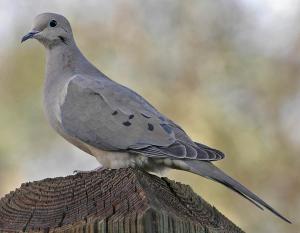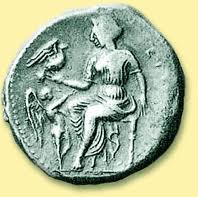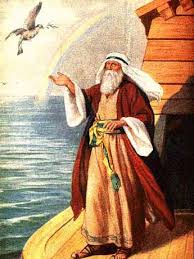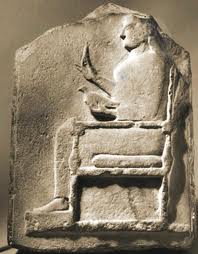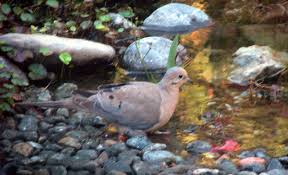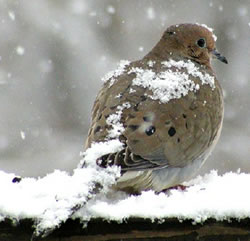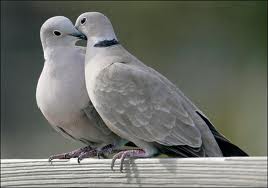“The voice of the turtle dove…”
New Year’s Day 2014 started out quietly. The night before had ended early for me because I had not been feeling well. However, I got up just after 8:00 the next morning, the first of January, in order to watch the famed Rose Parade on television. A bit morose because the year seemed to be starting out with a whimper not a bang, I trundled my aching body to the kitchen and pulled up the shade to look out on the garden in the morning light of another year.
Just above and to my left, sitting placidly preening on the corner of the front porch roof was a blue-gray mourning dove. It was just feet away from me on the other side of the kitchen window. “Okay,” I thought, “that ‘s rare. “ I have seen and heard a pair of doves that sits upon the crossbar of the telephone pole that stands at the corner of my property, but had never had one come so close to the house. Generally, they would sit there aloft, sometimes cooing, and then fly off high into the large oak tree adjacent, or they would take off into the sky.
Since the unusual appearance of animal, insect or bird always compels me to contemplate its meaning, I knew that I must take this visitation as a sign to conduct some research on this particular bird. After all, it had taken up such a close perch and come so near to my gaze early on that significant day of the year. Having thought that in that moment, and seeing more of its fellow doves throughout the month in various places, it still has taken me weeks to come around to write about it. A dove is such a well-known creature in the symbolism and lore of so many cultures that it would seem there is not much to add to the sum of all the commentaries. Yet the creature had shown itself to me at the very first part of the very first day of the year. I could not just ignore its epiphany so plainly displayed.
Now that we are closer to Valentine’s Day than to New Year’s Day, it seems most fitting to finally publish something about my New Year’s Day visitor since its most famous association—that of true romantic love—ties it in popular imagination to this particular holiday on February 14. Doves mate for life and thus have long been metaphors for the human aspiration for lasting romance. They were a commonly featured image on the elaborate Valentine cards of the 19th Century, but their connection to love, romantic and erotic, goes back thousands of years.
As far back as ancient times in the Middle East, doves accompanied goddesses Astarte, Inanna, Semiramis and Ishtar. That association with feminine divinity, sexuality, fertility and maternity continued for many centuries, becoming part of the symbolism of the Greek goddess Aphrodite and her later Roman counterpart, Venus. Doves were sacrificed to both by humans eager to gain an advantage in their amorous pursuits. Thankfully, we have left those practices behind and now mostly confine ourselves to using prayers and candles when imploring divine favor in matters of “amor”.
In Judaism, the dove is most famous first of all in the story of Noah and his ark. It was the dove with the olive branch in its beak that returned to Noah to show him that the great flood was actually receding and that dry land with trees still existed somewhere. Yahweh’s wrath towards humanity was spent and peace between man and his god was at hand. Today that symbol remains as the sign of peace among men, a state of existence that seems as elusive for humanity to manifest as is the attainment of everlasting romantic love.
Not surprisingly, it is the latter theme which is also evoked in the Old Testament of the Bible, in the Song of Solomon. In a well-known lyrical passage, the turtledove’s tender cry is the voice that announces the arrival of the season of love and the awakening of the heart.
But dove lore has also long connected the bird to prophecy. There is the Biblical figure of Jonah, the prophet, whose very name means “dove”, who was sent as Yahweh’s messenger to Ninevah. Interestingly, doves were also associated with prophecy in ancient Greek traditions at the site of Dodona. It was said that a “dove” (probably a priestess of a goddess) had founded the tradition in that place. Alexander the Great stopped there to consult the oracle before launching out on his campaign of conquest of the then-known world.
In Christianity, the dove is known for the role it played in the baptism of Jesus. The descent of the dove above Jesus’ head as he emerged from the water was taken as a sign of God’s favor, a sign that this man was the hoped-for Messiah. From that story is derived the ubiquitous use throughout many centuries in Christian art of the dove surrounded by golden light as the symbol of the Holy Spirit come to earth.
In North American Native American lore, the mourning dove is a rain dove, and it is a totem that for the Pueblo people of the southwest U.S. could lead them to water sources. The cooing of the doves at twilight drew people to the springs and pools where the birds would come to drink. So in a ritual sense the feathers of the rain dove were attached to prayer sticks, and the doves gentle song was thought to be an invocation to water itself.
The mourning dove of North America is, as its name suggests, sometimes connected to the notion of the soul’s passing from this life to the next. Thus, the appearance of the bird has been associated with visitation from the “other side”. This is not a new metaphor, nor is it only North American. It is usually understood to be a reassuring representation that life goes on, albeit separated from the still-living. It is perhaps why the most popular depictions of angels often show those heavenly emissaries with wings like those of a dove. This concept emerges, beautifully expressed, in a line from Charles Wright’s poem, “Appalachian Book of the Dead”: “…Doves settle, surreptitious angels, on tree limb and box branch… “ And it is visible in the grave marker below from Athens, Greece around 350 B.C.
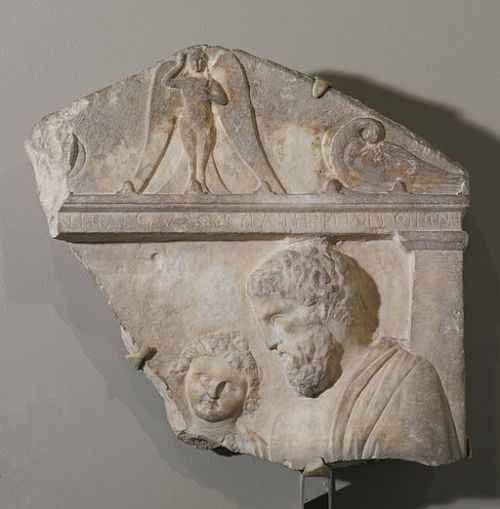
Fragment of a Grave Relief showing mourning dove in the right corner and angel above, circa 350 B.C.. Walters Art Museum, Baltimore, Maryland
And a few lines from a longer poem, ”Linnaeus in Lapland”, by Lorine Niedecker evokes the haunted feeling , the longing for love lost, that the mourning dove’s simple song may evoke:
Hear
where her snow-grave is
the You
ah you
of mourning doves
With all these rich and far-reaching symbolic qualities, doves of all kinds have been employed by poets to carry meanings that words can only suggest. In the following poem, Robert Bly contrasts the return of the dove to Noah’s ark, so often depicted and heralded, to that of a crow that actually came back with mud on his feet showing that floodwaters were receding. Somehow over the ages, the lovely dove seems to have stolen the crow’s thunder, so to speak, and the poet wants to give the dark bird its due:
Where We Must Look for Help
The dove returns; it found no resting place;
It was in flight all night above the shaken seas.
Beneath Ark eaves
The dove shall magnify the tiger’s bed;
Give the dove peace.
The split-tail swallows leave the sill at dawn;
At dusk blue swallows shall return.
On the third day the crow shall fly;
The crow, the crow, the spider-colored crow,
The crow shall find new mud to walk upon.
Another poet, Jared Carter, combines themes of love and loss, death and dream evoked by hearing the mourning doves call in the early morning:
Mourning Doves
That all my life I have listened to the calls
of mourning doves, have heard them hidden far back
under the eaves, or perched among sycamore branches—
their five still notes sometimes lost in the wind—
and not known how to answer: this I confess,
lying here now, on a summer morning, in a dark room
no less lit by the sound of their soft calling
than by your breathing. And though you might dream
that I lie stretched beside you, I am alone again,
and a child, hearing these same dim voices drifting
high outside my window, explaining to myself how
these are the cries of the newly dead, in the dawn light,
rising toward heaven. Only that, and a child’s need
to make up stories on falling asleep, or waking.
And though you might speak, out of that dream, or form
some forbidden word on your lips, my response
would be no more than the music two of them can make—
matching their notes in time, setting up harmonies
that are clear, and pure, and accidental even
to their own reckoning, since all of their singing
is circular, and comes back to the same stillness.
It is back to that place they are calling us now,
and it is out of not knowing that I brush away
strands of hair from your face, and begin to kiss
your eyes, your lips—that I might take sleep
from your mouth into mine, that we might dream invention,
and you hear my confession, and I your answering,
like a song traded back and forth in the morning light.
Well, I would say that Carter’s poem is a tribute to love, whether current or past, remembered or dreamt of, fitting for a truly romantic Valentine, so I will leave it right here, having come thus far up time’s river 2014 from January 1 to this point in time, “on the wings of a dove”.
Thinking mythologically,
Carol
Sources:
Wikipedia entry for “mourning dove”
Charles Wright’s poem is at: http://www.poetryfoundation.org/poem/177976
Jared Carter’s poem was found at: http://jaredcarter.com/poems/6/
You can link to Robert Bly’s poem at: http://www.wisdomportal.com/RobertBly/Bly-Anthology.html
Lorine Niedecker’s quoted poem can be accessed at:
http://www.poetryfoundation.org/poem/182882
Book source:
Animal Speak by Ted Andrews. Llewellyn Publications, Woodbury, Minnesota, 2005.

